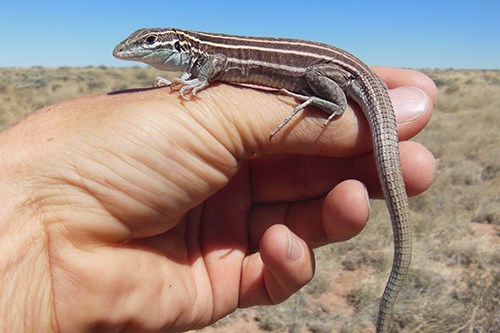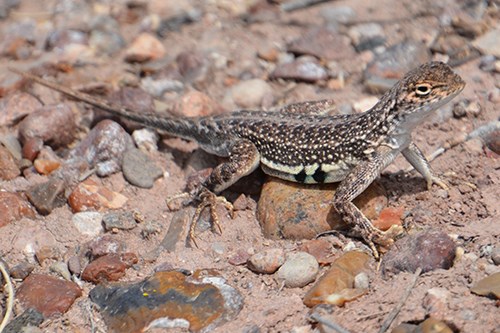
NPS/Marge Post Well-adapted to the often dry environment of Petrified Forest National Park, reptiles play an important part in maintaining the health of the ecosystem. Over sixteen varieties of lizards and snakes make Petrified Forest their home. Reptiles occupy a variety of habitats ranging from grassland to rocky slopes. They consume large quantities of insects, spiders, scorpions, other reptiles and small mammals thereby preventing infestations of any single species. Respecting the entire reptile community helps to preserve this vital link. All reptiles are "ectothermic," or cold-blooded, regulating body temperature via external sources rather than internal metabolism. The metabolic rate of a reptile is very low, but so are its energy needs. Keeping warm in the Arizona sunshine does not require much work, so energy generated can be used for reproduction and finding food instead of for heating and cooling. Of course, there are limitations to this type of adaptation. Since they cannot pant or sweat, reptiles are not able to endure extremely high temperatures without shade. They also cannot endure freezing temperatures. When it is cold, they hibernate or enter into an inactive torpor. The following is a list of the reptiles known to occur in the park. Help protect this important park ecosystem by observing our reptile inhabitants from a distance. 
NPS 
NPS/Andy Bridges 

NPS 
NPS/Andy Bridges 
NPS/Andy Bridges 
NPS/Lauren Carter 
NPS/Hallie Larsen 
NPS/Andy Bridges Common Side-blotched Lizard (Uta stansburiana) is a beautiful little lizard. Male side-blotched lizards compete for mates with a fascinating strategy that researchers liken to rock-paper-scissors. There are three types of males, with orange, yellow or blue throats. Oranges are larger, more aggressive, and have large territories with several females. Blues have smaller with just one female and blues cooperate for defense. Yellows are “sneakers” mimicking females, they don’t have territories and sneak into other males’ space to mate with their females, especially oranges as most blues fend them off. It’s been noted that some areas don’t have all the colors. 
NPS/Andy Bridges 
NPS/Andy Bridges 
NPS/Andy Bridges 
NPS/Hallie Larsen 
NPS/Andy Bridges 
NPS
Reptiles New Mexico Whiptail (Aspidoscelis neomexicanus) Pai Striped Whiptail (Aspidoscelis pai) Plateau Striped Whiptail (Aspidoscelis velox) Eastern Collared Lizard (Crotaphytus collaris) Western Earless Lizard (Holbrookia maculata) Greater Short-horned Lizard (Phrynosoma hernandesi) Common Sagebrush Lizard (Sceloporus graciosus) Plateau Fence Lizard (Sceloporus tristichus) Common Side-blotched Lizard (Uta stansburiana) Glossy Snake (Arizona elegans) Prairie Rattlesnake (Crotalus viridis) Chihuahuan Nightsnake (Hypsiglena jani) California King Snake (Lampropeltis californiae) Striped Whipsnake (Masticophis taeniatus) Desert Striped Whipsnake (Masticophis taeniatus ssp. taeniatus) Gopher Snake (Pituophis catenifer) |
Last updated: June 18, 2022
